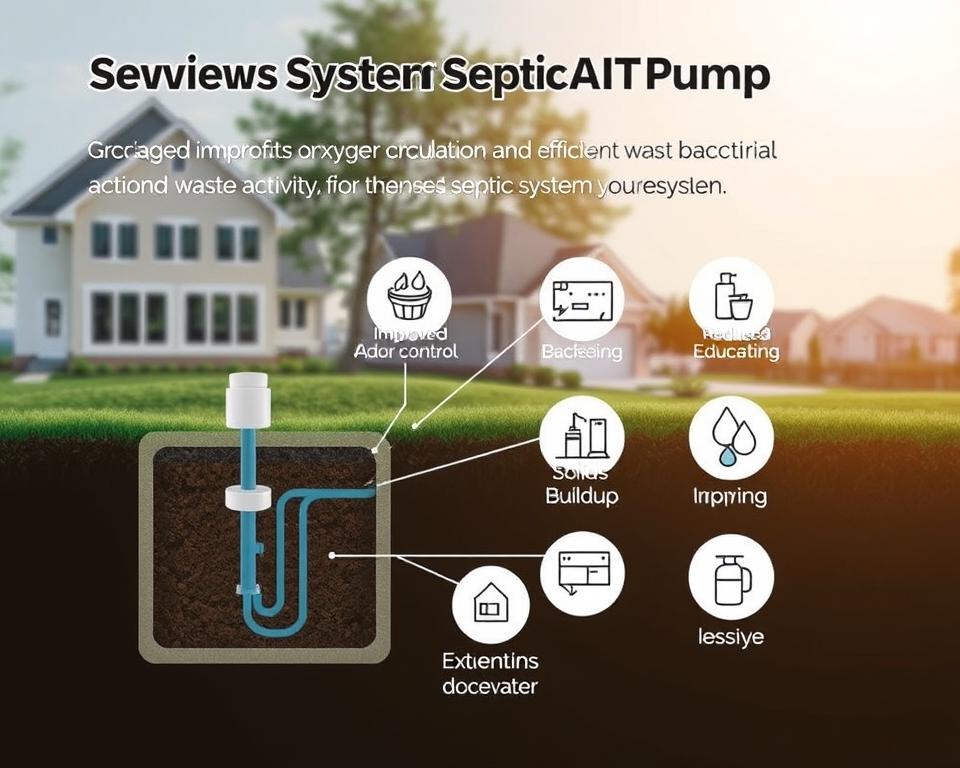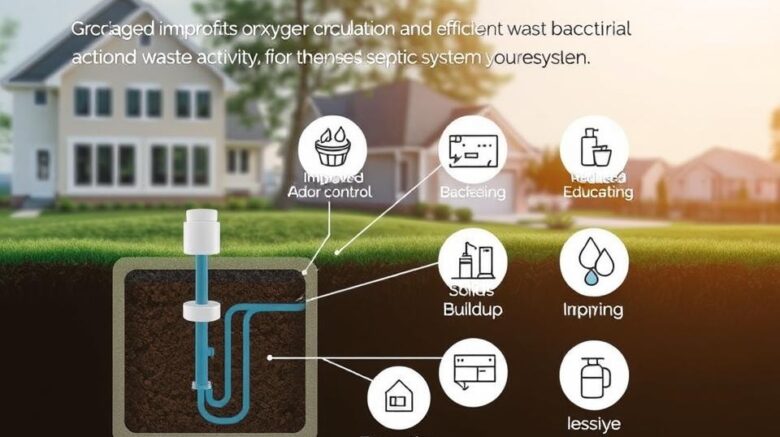Septic Tank Pump-Out: Must-Know Advice & Guidance
Have you considered exactly where your household waste goes after it leaves your kitchen sink or toilet? It’s handled by a properly maintained septic system. Understanding the vital role of septic tank pump-outs is indispensable for first-rate waste management at home. Overlooking this may cause backups and pricy fixes. Our guide is designed to reveal the value of septic servicing and routine pump outs. By calling on trustworthy septic services – septic cleaning, you shield your home, nature, and ensure your system’s longevity.
Noteworthy Points
- Routine septic tank pump out avoids system failures and backups.
- Grasping your septic system aids in efficient maintenance.
- Scheduling a pump out is critical for optimal waste management.
- Stay alert to signs that show your septic tank needs attention.
- Opting for a competent service provider can boost system efficiency.
- Investing in septic tank cleaning services defends your home and the environment.
Pump Out Importance Explained
Arranging a septic tank pumping service on a schedule is key for your system’s durability and performance. As years pass, your tank accumulates solid waste and organic debris, and this can lead to performance issues or even complete system failure. Without septic system maintenance, you could face obstructed pipes and damaged drain fields – problems that typically come with steep expenses and serious inconveniences for the household.
By having professional septic tank services handle regular maintenance, you ensure your system runs smoothly. This measure not only sidesteps expensive repairs but also protects the soil and groundwater around your home from pollution. Choosing regular pump outs, you support environmental health and enjoy a dependable and sound system for managing waste.
Understanding Your Septic System
A standard septic system is key in handling household wastewater. It’s constituted by the septic tank, drainfield, and soil – components that work together to efficiently process waste. The septic tank offers a contained space for solid waste to break down biologically.
It’s crucial for homeowners to grasp how these sections work. Maintaining the septic system in good condition is vital to its longevity and effectiveness. Through regular inspections and servicing the septic tank when necessary, owners can avoid expensive breakdowns that could lead to serious health and environmental issues.
Continuously servicing your septic system secures your property and supports public health. Below, find a table outlining the different septic system components and their functions:
| Component | Function |
|---|---|
| Septic Tank | Holds and breaks down solid waste through anaerobic bacteria. |
| Drainfield | Disperses the treated effluent into the soil for further filtration. |
| Soil | Acts as a natural filtration layer to further treat wastewater. |
Appreciating these elements underscores the need for careful septic system care. Effective operation depends on consistent maintenance and cleanings by homeowners.
How Often Should You Schedule a Pump Out?
Understanding when to get your septic tank pumped is essential for its wellbeing. Generally, a septic pump out should occur every three to five years. However, certain variables might adjust this schedule.
The occupancy level in your home significantly impacts the pumping frequency. More inhabitants mean more wastewater, creating a need for more recurrent maintenance. Moreover, habits like frequent washing or long showers might require sooner pump outs. Taking early actions can notably improve your septic system’s life.
It’s smart to factor in individual elements, such as tank size and daily water use, to follow a proper schedule. Tracking your last pump out date helps with timely planning for the next one, ensuring uninterrupted system performance.
Indicators It’s Time to Pump
Homeowners should be watchful for indications that show their septic tank needs pumping. Slow-draining sinks and toilets often indicate an full septic system, impeding the wastewater flow. Moreover, unpleasant smells around your home could indicate issues; they may come from the tank, showing system failure.
Visible wastewater pooling in the yard is another clear indicator. When you see waterlogged patches or unexplained puddles, it’s likely your septic system is overloaded. Overlooking these signs can grow into more critical issues that disrupt your home and become expensive to resolve.
To head off serious complications, proactive maintenance is crucial. Hiring a professional service like All in Sanitation can be a smart move. They can properly diagnose and resolve these signs. This strategy not only handles immediate issues but also maintains your system’s efficiency and health.

Picking the Right Pump Out Service
It’s crucial to select a competent septic tank pumping service to ensure your system operating well. Reputable companies understand the local regulations thoroughly, ensuring your septic system meets all requirements. A solid service, like All in Sanitation, is committed to disposing of waste in an eco-friendly manner. This is critical for the environment’s well-being.
While looking for the right septic service, consider these critical points:
- Experience and Reputation: Choose companies with strong feedback and long-standing success in your region.
- Licensing and Insurance: Check that your preferred provider has the required license and insurance to cover unexpected problems.
- Comprehensive Services: Prefer a service that offers inspections with pumping, identifying issues before they get worse.
Paying for a good septic tank pumping service wards off big future repairs. Regular evaluations and steady upkeep keep your system in optimal condition. Picking carefully not only safeguards your investment but also supports a sound waste management system for your home.
Cleaning Your Septic Tank
For homeowners, septic tank cleaning is essential to guarantee the system works well. During this process, eliminating sludge and scum is key to prevent blockages. A cleaned system not only functions better but also lasts longer. Conducting regular cleanings is important for the health of your system.
Many homeowners seek extra services to boost septic tank care. These extras are beneficial for removing harmful bacteria and halting residue build-up. Understanding the necessity of proper maintenance can spare you costly overhauls. Remaining proactive in maintenance guarantees both environmental safety and household well-being.
What Pumping Services Cost
Homeowners need to grasp septic tank pumping costs for smooth system maintenance. Prices vary greatly due to region, tank size, and selected service provider. Typically, this service costs between $200 and $600. It’s advisable to get estimates from multiple companies, weighing both expertise and reliability.
Service providers like All in Sanitation offer affordable rates. Yet, the cost of septic tank cleaning represents service quality and thoroughness. Homeowners should consider these aspects carefully when choosing a service.
Comparing quotes assists smart selections that fit your budget and septic system needs. Understanding potential costs helps with financial planning for septic tank upkeep.
Keeping Your Septic System Healthy
Caring for your septic system correctly is critical. It ensures a durable and well-functioning setup. By implementing easy steps, the longevity of your septic tank improves, while also saving money. Practices like cutting back on water consumption in your household make a big difference. Repairing leaks promptly and opting for water-saving appliances are smart steps.
It’s crucial to refrain from flushing harmful substances down the drain. Chemicals, fats, or things that won’t decompose hurt your septic system. For the wellbeing of your setup, discard such waste responsibly. This approach protects your septic tank’s natural processes.
Consistent inspections and the occasional pumping are essential for septic maintenance. Try to have your system checked and serviced every three to five years. A maintenance schedule or checklist can be very useful. It assists homeowners in monitoring their system’s condition and sticking to maintenance guidelines.
Being proactive with septic maintenance delivers financial and environmental gains. By incorporating these habits, homeowners enhance their septic systems’ efficiency and dependability. This commitment not only preserves your system but also contributes to a healthier environment.
The Final Word
A septic tank pump out is essential for septic tank upkeep, and homeowners need to consider it seriously. It prevents costly fixes and increases the system’s lifespan, guaranteeing smooth operation over years. Knowing when to act on system distress signals safeguards your property.
Opting for a proven provider, like All in Sanitation, makes all the difference in septic tank care. Their expertise secures proper service, promoting both environmental health and your home’s comfort. Preventive care secures your investment and supports a greener planet.
Staying informed about your septic system and its maintenance needs is crucial. Scheduled pump outs improve home functionality and reinforce public health. For any homeowner, grasping the importance of septic tank care secures a problem-free living environment for the future.
